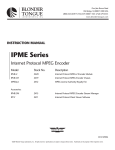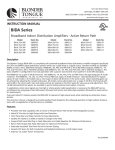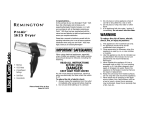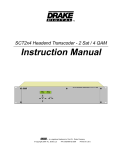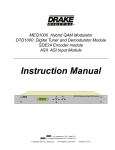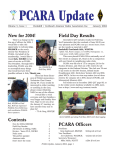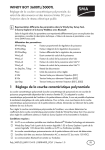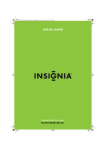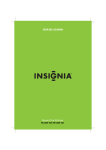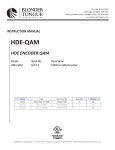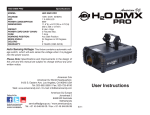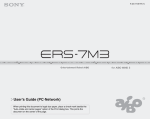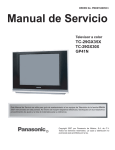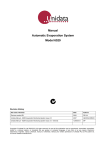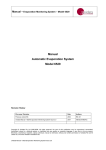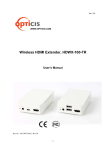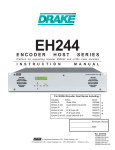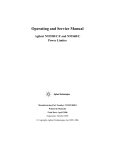Download DQMx User Manual
Transcript
One Jake Brown Road Old Bridge, NJ 08857-1000 USA (800) 523-6049 • (732) 679-4000 • FAX: (732) 679-4353 www.blondertongue.com INSTRUCTION MANUAL DQMx Series Digital QAM Multiplexer Model Stock No. DQMx-XY 6259A XY DQMx-RF 6256 DQMx-ASI 6257 DQMx 6259A Description Digital QAM Multiplexer with "X" ASI input modules and "Y" 8VSB/QAM input modules 8VSB/QAM Input Module ASI/Input Module Digital QAM Multiplexer Mainframe Status Date Document No. Issue No. Author Active Aug. 29, 2012 651221000F 6 KK Obsolete May 19, 2011 651221000E 5 AB Obsolete Jan. 25, 2011 651221000D 4 KK Obsolete Jun. 26, 2009 651221000C 3 AB Obsolete Mar. 19, 2009 651221000B 2 AB Obsolete Aug. 25, 2008 651221000A 1 JB ©2011 Blonder Tongue Laboratories, Inc. All rights reserved. Specifications are subject to change without notice. Trademarks are the property of their respective owner. 2 DQMx Series Instruction Manual We recommend that you write the following information in the spaces provided below. Purchase Location Name: Purchase Location Telephone Number: DQMx Serial Number: The information contained herein is subject to change without notice. Revisions may be issued to advise of such changes and/or additions. Correspondence regarding this publication should be addressed directly to: Blonder Tongue Laboratories, Inc. One Jake Brown Road Old Bridge, NJ 08857 Document Number: 651221000F Printed in the United States of America. All product names, trade names, or corporate names mentioned in this document are acknowledged to be the proprietary property of the registered owners. This product incorporates copyright protection technology that is protected by U.S. patents and other intellectual property rights. Reverse engineering or disassembly is prohibited. Table of Contents DQMx Series 3 Instruction Manual SECTION 1 – GENERAL & SAFETY INSTRUCTIONS........................................................................................................ 4 SECTION 2 – PRODUCT SUMMARY............................................................................................................................... 6 2.1 REVISION HISTORY & REASON..................................................................................................................................... 6 2.2 PRODUCT APPLICATION & DESCRIPTION..................................................................................................................... 6 2.3 PRODUCT SPECIFICATION............................................................................................................................................ 8 SECTION 3 – INSTALLATION & POWER-UP................................................................................................................... 9 3.1 UNPACKING.................................................................................................................................................................. 9 3.2 INSTALLATION............................................................................................................................................................... 9 3.3 POWER-UP.................................................................................................................................................................. 10 SECTION 4 – CONFIGURATION..................................................................................................................................... 11 4.1 GENERAL..................................................................................................................................................................... 11 4.2 QUICK CONFIGURATION MODULES............................................................................................................................ 14 SECTION 5 – INPUT MODULE MENU........................................................................................................................... 15 5.1 ASI INPUT MODULE: GENERAL................................................................................................................................... 15 5.2 ASI INPUT MODULE: “TSID” PARAMETER................................................................................................................... 15 5.3 ASI INPUT MODULE: “MJR OFFSET” PARAMETER...................................................................................................... 15 5.4 ASI INPUT MODULE: “PID OFFSET” PARAMETER....................................................................................................... 16 5.5 ASI INPUT MODULE: “PROGRAM #” PARAMETER...................................................................................................... 16 5.6 8VSB/QAM INPUT MODULE: GENERAL...................................................................................................................... 17 5.7 8VSB/QAM INPUT MODULE: “TSID” PARAMETER...................................................................................................... 17 5.8 8VSB/QAM INPUT MODULE: “MJR OFFSET” PARAMETER......................................................................................... 17 5.9 8VSB/QAM INPUT MODULE: “PID OFFSET” PARAMETER.......................................................................................... 18 5.10 8VSB/QAM INPUT MODULE: “BAUD RATE” PARAMETER.......................................................................................... 18 5.11 8VSB/QAM INPUT MODULE: “CHANNEL NO” PARAMETER....................................................................................... 19 5.12 8VSB/QAM INPUT MODULE: “RF MODE” PARAMETER............................................................................................. 19 5.13 8VSB/QAM INPUT MODULE: “MODULATION” PARAMETER...................................................................................... 19 5.14 8VSB/QAM INPUT MODULE: “PROGRAM #” PARAMETER......................................................................................... 19 SECTION 6 – QAM MENU............................................................................................................................................. 20 6.1 GENERAL..................................................................................................................................................................... 20 6.2 QAM MENU: “GRAY MODE” PARAMETER.................................................................................................................. 20 6.3 QAM MENU: “INTERLEAVE” PARAMETER................................................................................................................... 20 6.4 QAM MENU: “ALPHA” PARAMETER............................................................................................................................ 20 6.5 QAM MENU: “BAUD RATE” PARAMETER.................................................................................................................... 21 6.6 QAM MENU: “MODULATION” PARAMETER............................................................................................................... 21 6.7 QAM MENU: “ENCODE MODE” PARAMETER............................................................................................................. 21 6.8 QAM MENU: “MODE” PARAMETER............................................................................................................................ 21 SECTION 7 – RF OUTPUT MENU.................................................................................................................................. 22 7.1 GENERAL..................................................................................................................................................................... 22 7.2 RF MENU: “FIRMWARE” PARAMETER........................................................................................................................ 22 7.3 RF MENU: “OUTPUT LEVEL” PARAMETER................................................................................................................... 22 7.4 RF MENU: “OUTPUT CHANNEL #” PARAMETER......................................................................................................... 22 7.5 RF MENU: “OUTPUT MODE” PARAMETER................................................................................................................. 22 SECTION 8 – MUX OUTPUT MENU.............................................................................................................................. 23 8.1 GENERAL..................................................................................................................................................................... 23 8.2 MUX OUTPUT: CVCT ENABLE...................................................................................................................................... 23 8.3 MUX OUTPUT: OUT TSID............................................................................................................................................. 23 8.4 MUX OUTPUT MENU: “PSIP ENABLE” PARAMETER................................................................................................... 23 8.5 MUX OUTPUT MENU: “RESCAN ALL” PARAMETER.................................................................................................... 23 8.6 MUX OUTPUT MENU: “FACTORY DEFAULT” PARAMETER.......................................................................................... 24 8.7 MUX OUTPUT MENU: “VERSION” PARAMETER......................................................................................................... 24 8.8 MUX OUTPUT MENU: “ADDRESS” PARAMETER......................................................................................................... 24 8.9 MUX OUTPUT MENU: “PROGRAM #X” PARAMETER................................................................................................. 24 SECTION 9 – FREQUENTLY ASKED QUESTIONS........................................................................................................... 25 APPENDIX A – MEASURING THE QAM OUTPUT SIGNAL LEVEL................................................................................. 27 4 DQMx Series Instruction Manual Section 1 — General & Safety Instructions The STOP sign symbol is intended to alert you to the presence of REQUIRED operating and maintenance (servicing) instructions that if not followed, may result in product failure or destruction. The YIELD sign symbol is intended to alert you to the presence of RECOMMENDED operating and maintenance (servicing) instructions. The LIGHTNING flash symbol is intended to alert you to the presence of uninsulated "dangerous voltage" within the product's enclosure that may be of sufficient magnitude to constitute a risk of electrical shock. TO REDUCE THE RISK OF ELECTRICAL SHOCK, DO NOT REMOVE COVER FROM THIS UNIT. NO USER-SERVICEABLE PARTS INSIDE. REFER SERVICING TO QUALIFIED SERVICE PERSONNEL. WARNING: TO PREVENT FIRE OR SHOCK HAZARD, DO NOT EXPOSE THIS UNIT TO RAIN OR MOISTURE NOTE TO CATV SYSTEM INSTALLER This reminder is provided to call the CATV System Installer’s attention to Article 820-40 of the NEC that provides guidelines for proper grounding and, in particular, specifies that the cable ground shall be connected to the grounding system of the building, as close to the point of cable entry as practical. Safety Instructions YOU SHOULD ALWAYS FOLLOW THESE INSTRUCTIONS TO HELP ENSURE AGAINST INJURY TO YOURSELF AND DAMAGE TO YOUR EQUIPMENT. ➥ Read all safety and operating instructions before you operate the unit. ➥ Retain all safety and operating instructions for future reference. ➥ Heed all warnings on the unit and in the safety and operating instructions. ➥ Follow all installation, operating, and use instructions. ➥ Unplug the unit from the AC power outlet before cleaning. Use only a damp cloth for cleaning the exterior of the unit. ➥ Do not use accessories or attachments not recommended by Blonder Tongue, as they may cause hazards, and will void the warranty. ➥ Do not operate the unit in high-humidity areas, or expose it to water or moisture. ➥ D o not place the unit on an unstable cart, stand, tripod, bracket, or table. The unit may fall, causing serious personal injury and damage to the unit. Install the unit only in a mounting rack designed for 19” rack-mounted equipment. DQMx Series 5 Instruction Manual Safety Instructions - continued ➥ D o not block or cover slots and openings in the unit. These are provided for ventilation and protection from overheating. Never place the unit near or over a radiator or heat register. Do not place the unit in an enclosure such as a cabinet without proper ventilation. Do not mount equipment in the rack space directly above or below the unit. ➥ O perate the unit using only the type of power source indicated on the marking label. Unplug the unit power cord by gripping the plug, not the cord. ➥ T he unit is equipped with a three-wire ground-type plug. This plug will fit only into a ground-type power outlet. If you are unable to insert the plug into the outlet, contact an electrician to replace the outlet. Do not defeat the safety purpose of the ground-type plug. ➥ R oute power supply cords so that they are not likely to be walked on or pinched by items placed upon or against them. Pay particular attention to cords at plugs, convenience receptacles, and the point where they exit from the unit. ➥ B e sure that the outdoor components of the antenna system are grounded in accordance with local, federal, and National Electrical Code (NEC) requirements. Pay special attention to NEC Sections 810 and 820. See the example shown in the following diagram: ➥ W e strongly recommend using an outlet that contains surge suppression or ground fault protection. For added protection during a lightning storm, or when the unit is left unattended and unused for long periods of time, unplug it from the wall outlet and disconnect the lines between the unit and the antenna. This will prevent damage caused by lightning or power line surges. ➥ D o not locate the antenna near overhead power lines or other electric light or power circuits, or where it can fall into such power lines or circuits. When installing the antenna, take extreme care to avoid touching such power lines or circuits, as contact with them can be fatal. ➥ Do not overload wall outlets or extension cords, as this can result in a risk of fire or electrical shock. ➥ N ever insert objects of any kind into the unit through openings, as the objects may touch dangerous voltage points or short out parts. This could cause fire or electrical shock. ➥ D o not attempt to service the unit yourself, as opening or removing covers may expose you to dangerous voltage and will void the warranty. Refer all servicing to authorized service personnel. ➥ Unplug the unit from the wall outlet and refer servicing to authorized service personnel whenever the following occurs: ❏ The power supply cord or plug is damaged; ❏ Liquid has been spilled, or objects have fallen into the unit; ❏ The unit has been exposed to rain or water; ❏ The unit has been dropped or the chassis has been damaged; ❏ The unit exhibits a distinct change in performance. ➥ W hen replacement parts are required, ensure that the service technician uses replacement parts specified by Blonder Tongue. Unauthorized substitutions may damage the unit or cause electrical shock or fire, and will void the warranty. ➥ U pon completion of any service or repair to the unit, ask the service technician to perform safety checks to ensure that the unit is in proper operating condition. Returning Product for Repair (or Credit) A Return Material Authorization (RMA) Number is required on all products returned to Blonder Tongue, regardless if the product is being returned for repair or credit. Before returning product, please contact the Blonder Tongue Service Department at 1-800-523-6049, Ext. 4256 or visit our website: www.blondertongue.com for further information. 6 DQMx Series Instruction Manual Section 2 — Product Summary 2.1 Revision History & Reason This is the sixth issue of this Instruction Manual. Added reference in Section 5.4 regarding PID offsets changing program numbers. Previously only minor channel numbers were mentioned. 2.2 Product Application & Description Application: The DQMx multiplexer can be equipped with up to four (4) input modules. There are two types of input modules available: ASI and 8VSB/QAM. Any mix of input modules are allowed, for example, DQMx can be equipped with two ASI input modules and 2 8VSB/QAM input modules. Operator can select which programs within each input stream are to be filtered or passed on. The resulting output stream is QAM modulated and upconverted to an RF channel with a set of automatically generated PSI (Program Specific Information) and PSIP (Program & System Information Protocol) tables. The data rate can be up to 38.8 Mbps for transmission in a single 6 MHz, QAM 256 channel or higher with QAM 512 and 1024. The DQMx supports standard EIA CATV, IRC, HRC and Broadcast channel plans in the 54 – 864 frequency range. All channel frequency information, with appropriate FCC offsets, is pre-programmed and tuned electronically via microprocessor. The ASI input can come from multiple sources, such as Blonder Tongue’s AQD Plus ASI (# 6244 10) or DAP Plus ASI (#6295 10), integrated satellite receiver/decoders (IRDs), broadcast station fiber feeds, or file/video servers. DQMx Series 7 Instruction Manual Description: Below are the front and rear pictures of the unit: MUX OUTPUT [1] [2] [1] & [2] LCD SCREEN & KEY-PAD: The LCD has 2 lines, each capable of displaying 16 characters. The key-pad has 5 push-down buttons used to navigate between menus and to program unit information. Input Module Compartment (with removable cover) [3] [4] [5] [6] [7] [3] POWER: An IEC power cord socket THE ACCEPTABLE INPUT VOLTAGES ARE 110 VAC/60 Hz & 220 VAC/ 50 Hz. [4] FUSE HOLDER: 1.0 Amp., 250V DC, Slo Blo Fuse [5] RS232 SERIAL DATA PORTS: RJ-11 IN/OUT connectors provide a single access point for multiple DQMx units via daisy-chaining — future upgrade. [6] QAM RF OUTPUT: 75 Ω F connector [7] INPUT MODULES: ASI - 75 Ω BNC connector OR 8VSB/QAM - 75 Ω F connector ASI Input Module Model: DQMx-ASI Stock: 6257 8VSB/QAM Input Module Model: DQMx-RF Stock: 6256 8 DQMx Series Instruction Manual 2.3 Product Specification INPUT OUTPUT Connector: “F” Female Connectors ASI module: BNC Female 8VSB/QAM module: “F” Female Standards QAM Modulation Modes: 16, 32, 64, 128, 256, 512, and 1024 DVB Symbol Rate: Variable; 1 to 7 MSymbols/sec (MBaud) ASI: DVB-ASI; EN 50083-9 8VSB: ATSC Digital Television A/53E QAM : ITU-T J.83 - Annex A & B (64 and 256 QAM) ASI Mode Transport Rate: 270 Mbps (desired transport rate of 10.76 MSymbols/sec) 8VSB Mode Tuning Range: Data Rate: Bandwidth: Power Level: QAM Mode Tuning Range: Data Rate: Bandwidth: Power Level: Frequency Range: QAM Tuning 54 to 864 MHz NTSC: Per channel’s number from 2 to 135 PAL: Per channel’s center-frequency (12.5 kHz increments) RF Level: +60 dBmV ±1 (120 dBμV ±1) UHF (NTSC Ch. 14-69), VHF (NTSC Ch. 2-13) 19.392 Mbps 6 MHz -20 to +20 dBmV RF Level LCD Screen Error: ± 2 dB RF Level Adjustment Range: 50 to 60 dBmV Frequency Stability: ± 10 kHz over 32 to 122 °F (0 to 50 °C) CATV (NTSC Ch. 2-135) 38.8 Mbps (QAM 256); 26.97 Mbps (QAM 64) – Auto Detect 6 MHz -15 to 20 dBmV (@ QAM 256) -20 to 20 dBmV (@ QAM 64) Frequency Tolerance: ± 0.5 kHz @ 77 °F (25 °C) Amplitude Flatness: ± 0.25 dB (over 6 MHz channel) Phase Noise: -98 dBc (@ 10 kHz) Spurious: -60 dBc Broadband Noise: -75 dBc (@ +60 dBmV output level, 4 MHz bandwidth) Impedance: 75 Ω Return Loss: 12 dB Spectral Inversion: Auto Recognition Carrier Suppression: 55 dB SNR: Greater than 40 dB MER: Greater than 40 dB I/Q Phase Error: Less than 1 degree I/Q Amplitude Imbalance: Less than 1% Impedance: 75 Ω General Dimensions (W x D x H): 19.0 x 14.3 x 1.75 inches (483 x 363 x 44 mm) Power: 105 to 240 VAC/50 to 60 Hz Power Dissipation: 36 W (fully loaded with 4 input modules) Weight: 5.1 lbs (2.31 kg) Operating Temperature: 32 to 122 °F (0 to 50 °C) Storage Temperature: -13 to 158 °F (-25 to 70 °C) Operating Humidity: 0 to 95% RH @ 35 °C max, non-condensation Local Monitoring: Local Control: Front-panel 16-character, 2-line LCD screen Front-panel Navigational Key-pad Storage Humidity: 0 to 95% RH @ 35 °C max, non-condensation Remote Monitoring/Control: Not available Alarms/Monitoring/Control DQMx Series 9 Instruction Manual Section 3 – Installation & Power-up 3.1 Unpacking You will find the following items in the box: • DQMx Multiplexer (QTY=1) • Power Cord with IEC C13 line socket and 3-pin Type B NEMA 5 Plug (QTY=1) 3.2 Installation The DQMx multiplexer is designed to be installed in a standard 19-inch (480 mm) rack (EIA 310-D, IEC 60297, and DIN 41494 SC48D). To install the encoder, secure its front panel to the rack by inserting four machine screws, with cup washers, through the four mounting holes in the front panel. DO NOT BLOCK THE UNIT’S AIR INTAKE OR AIR DISCHARGE OPENINGS. It is recommended to leave 1 rack unit space (1RU = 1.75 inch = 44.45 mm) between each encoder to reduce heat build-up in the rack which helps to extend the product’s life span. FOR SAFE AND RELIABLE OPERATION, THE GROUND PIN OF THE POWER CORD PLUG MUST BE GROUNDED PROPERLY. 10 DQMx Series Instruction Manual 3.3 Power-up There is no power On-OFF switch on this unit. To turn the unit on or off, simply connect/disconnect the power cord to/from the unit. The unit’s power inlet plug is equipped with a fuse-holder and fuse. The following sequence of events will take place when the unit is powered-up successfully: Initializing MUX Please wait… MUX Initialized The unit will then automatically check for the presence of input modules. The LCD displays the following when valid inputs are present: Updating MUX Please wait… MUX Output Has Been Updated! The display defaults to the "MUX OUTPUT MENU" after 10 seconds of inactivity. More details on the "MUX OUTPUT MENU" can be found on Section 8. MUX OUTPUT MENU or Status: OK MUX OUTPUT MENU Overflow Error! The LCD has a backlit feature to illuminate the panel. It will light when any of the key-pad buttons are pressed. It will automatically turn off if no interaction is made after about 25 seconds. DQMx Series 11 Instruction Manual Section 4 – Configuration 4.1 General Configuration and monitoring of the unit is accomplished by utilizing the front-panel LCD and Key-pad. Configuration of the unit is accomplished from the five push-down buttons on the front-panel key-pad: t (L), u (R), p (UP), q (DN), and Enter. Diagram 1 depicts the LCD screens and parameters in the main interactive sequence. NO UNIT ADJUSTMENTS ARE PERMITTED IN THE t (L) or u (R). ALL MODIFICATION MUST BE PERFORMED IN THE p (UP)/ q (DN) SEQUENCE. 1.Press the t (L) or u(R) buttons to switch among different menus. 2.Press the p (UP) or q (DN) buttons to scroll to the desired interactive parameter. 3.When you arrive at the screen whose parameter needs to be changed, press and hold for about 2 seconds the ENTER button until the blinking cursor is displayed. 4.Press the p (UP) or q (DN) buttons to increment or decrement to the appropriate desired value. 5.Press the ENTER button again to apply the change to the unit's memory. The control board then programs the unit to the new setting. 6.You'll see the following confirmation message on the LCD screen: Entry Accepted 12 DQMx Series Instruction Manual Input Module Menu (see section 5 for more detail) IN4:TSID tu tu IN2:MJR Offset 0000 u u u 8VSB INPUT# 4 MENU IN3:TSID tu tu tu u u u u u 8VSB INPUT# 3 MENU tu IN2:TSID IN1:MJR Offset 0000 t ASI INPUT#2 MENU Stream Present tu IN1:TSID t t t ASI INPUT#1 MENU Stream Present IN3:MJR Offset 0000 IN4:MJR Offset 0000 tu tu tu tu IN1: PID Offset Auto Offset IN2:PID Offset 0000 IN3:PID Offset 0000 IN4:PID Offset 0000 tu tu tu IN2:Prog# 3 2-3 IN3:Baud Rate 5.3811 MBd/sec IN4:Baud Rate 5.3811 MBd/sec tu tu tu IN2:Prog# 2 2-2 000 IN4:Channel No. 000 tu tu IN1: Prog# 3 6-3 WBTL-WX [1] IN1: Prog# 2 * 6-2 WBTL-SD IN2:Prog# 1 2-1 tu tu tu tu IN1: Prog# 1 6-1 WBTL-HD IN3:RF Mode Air Broadcast IN4:RF MODE CATV Standard tu u t u t AirNormal Broadcast CATV Standard CATV HRC CAV IRC tu tu Diagram #1 IN3:Modulation 8VSB Off-Air IN4:Prog# 713 13-1 WNET-HD tu IN1:Prog# 131 13-2 KIDS u t IN3:Prog#1 5-1 WNYW-D5 IN4:Prog# 199 13-3 V-ME tu tu • Factory default values, when applicable, are highlighted in black in the diagram above. IN3:Prog#2 5-2 WWOR-D5 IN4:Prog# 702 2-1 WCBS-HD tu CATV QAM 64B CATV QAM 256B CATV QAM 32A • This is an example of a unit equipped with 2 ASI Input Modules (inputs 1 & 2), and 2 8VSB/QAM Input Modules; one receiving an 8VSB input (input 3) and the other receiving a QAM input (input 4). • Factory default for ASI INPUT menu is "NOT FILTERED". tu 8VSB Off-Air Normal COMMENTS: tu See Next Page u t DQMx Series 13 Instruction Manual QAM Menu RF Output Menu MUX Output Menu (See section 6 for more detail) (See section 7 for more detail) (See section 8 for more detail) QAM: GRAY MODE DAVIC tu tu DAVIC DVB tu QAM: INTERLEAVE I128, J1 Range: 48 to 62 tu MUX: PSIP ENABLE YES RF: OUTPUT CH# 2 2 tu tu tu 12% 15% 18% 2 to 135 t Range: 1 to 6.9 HRC IRC u tu Diagram #1 NOTES: ITU-T Annex Annex B B [1] In the Input Module menus "*" means the program was filtered. t [3] In the MUX OUTPUT menu "*" means the program was remapped. [3] MUX: *Prog# 2 2-1 WCBS-HD tu [2] The Gray Mode is available in ITU-A only. MUX: Prog# 1 6-1 WBTL-HD u t Normal Normal PRBS 23M PRBS 23 PRBS 15M PRBS 15 Inverted Off MUX: Prog# 3 6-3 WBTL-WX tu tu ITU-T Annex A QAM: MODE Normal MUX: ADDRESS 16777215 tu QAM: ENCODE MODE ITU-T Annex B YES MUX: VERSION 04:02.04:02.04 tu QAM: MODULATION QAM 256 16 32 64 128 256 512 1024 YES MUX: FACTORY DEF NO tu tu Standard NTSC YES MUX: RESCAN ALL NO tu QAM: BAUD RATE 5.3605 5.3605 MBd/Sec NO YES MUX:OUT TSID 00001 RF: OUTPUT LEVEL 60 dBmV 60 dBmV tu ITU-B I128,J1 I128, J1 I128, J2 I64, J2 I128, J3 I32, J4 I128, J4 I16, J8 I128, J5 I8, J16 I128, J6 I4, J32 I128, J7 I2, J64 I128, J8 I1, J128 MUX:CVCT ENABLE NO RF: FIRMWARE Version 1.0 tu ITU-A I204, J1 I1, J204 I2, J102 I3, J68 I4, J51 I6, J34 I12, J17 I17, J12 I34, J6 I51, J4 I68, J3 I102, J2 MUX OUTPUT Status: OK u u [2] tu u u u See Previous Page RF OUTPUT MENU Status: OK u tu QAM MENU Status: OK t t t tu u 14 DQMx Series Instruction Manual 4.2 Quick Configuration 1. Connect desired Input Modules: either ASI or 8VSB/QAM. Each input module will auto-detect its corresponding input stream. There are no input configurations needed for the ASI input module. However, you must configure the 8VSB/QAM input module. See section 5 for details. Please pay attention to the maximum input bandwidth that the unit and input modules can handle. A more detailed guide to maximum input bandwidth and output bandwidth limitations can be found in Section 9. 2. Connect the RF output F connector to the headend combiner or device of your choice. 3. Setting Output Level: The factory default is already set at the maximum output signal-to-noise ratio (SNR) of 60 dBmV. It is not recommended to change this setting. However, if you need to fine-tune the setting, follow these steps. a. Using the t (L) or u (R) buttons, navigate to the "RF OUTPUT MENU". b. Using the p (UP) or q (DN) buttons, navigate to the "RF: OUTPUT LEVEL" menu. Press and hold for about 2 seconds the ENTER button until you see a flashing cursor. You can now change the output level in 1 dB increments by using the p (UP) or q (DN) buttons. c. Once you have arrived at the desired output level press the ENTER button. You will receive the following confirmation message on the front panel LCD screen: "Entry Accepted" 4. Setting Output QAM Channel: a. Using the t (L) or u (R) buttons, navigate to the "RF OUTPUT MENU". b. Using the p (UP) or q (DN) buttons, navigate to the "RF: OUTPUT CH#" menu. Press and hold for about 2 seconds the ENTER button until you see a flashing cursor. You can now change the output channel by using the p (UP) or q (DN) buttons. c. Once you have arrived at the desired output channel press the ENTER button. You will receive the following confirmation message on the front panel LCD screen: "Entry Accepted" d. Please see Section 7.2 if a channel plan other than standard NTSC is desired. 5. Eliminating Undesired Program Streams: a. Using the t (L) or u (R) buttons, navigate to the Input Module that you would like to eliminate program streams from. i. The LCD will display either "ASI INPUT # x" or "8VSB/QAM INPUT # x" depending on the type and quantity of Input Modules installed, where "x" is the numeric position of the Input Module installed in DQMx - namely, 1 through 4. ii. For a detailed map of the unit’s interactive menu, please see Section 4.1. b. When you have found the Input Module that you would like to eliminate program streams from, use the p (UP) or q (DN) buttons to scroll through all of the available program streams on that Input Module. i. The program streams are identified by the program number that is inserted into the stream by the content provider. If you were receiving programming from a broadcast source, you could expect to see: 1. Program number (1, 2, 3…) 2. The broadcaster’s Major- and Minor-channel numbers, for example: 6-1(major), 6-2(minor), 6-3(minor), .... 3. Station call letters (WBTL-HD, WBTL-SD, WBTL-WX,...) c. When you have found the program number that you would like to eliminate, press and hold for about 2 seconds the ENTER button until you see a flashing cursor. d. Using the p (UP) or q (DN) buttons you can eliminate the program by making an asterisk appear/disappear in the first position on the second line of the front-panel LCD. When you have the asterisk displayed on the program stream that you wish to eliminate, press the ENTER button. e. You will receive several rapid confirmation messages on the front-panel LCD to confirm that the change has taken place and that all of the appropriate output tables are being updated. The final message will be: "MUX Output Has Been Updated!". The program stream that was marked with the asterisk will no longer be present in the multiplexed QAM output channel. DQMx Series 15 Instruction Manual Section 5 – Input Module Menu Each Input Module will auto-detect its corresponding input stream. The ASI module requires no configuration. The 8VSB/QAM module, however, needs to be configured depending on whether the input is in 8VSB format (Digital Off-air) or in QAM format (Digital Cable). The factory default values are selected to minimize the necessary configuration steps. However, you can change the factory default value of any of the menu options. In this section we provide an explanation of these options, and instructions on how to change them. 5.1 ASI Input Module: General DQMx will automatically detect the type of Input Module that is installed on each of its four input slots. If an ASI Input Module is detected, then the unit will search for the presence of an input stream on that module and one of the following two messages will appear on the LCD: ASI INPUT# 1 Stream Present or ASI INPUT# 1 Stream Absent If an input stream is present, the Input Module will automatically scan and lock to the input stream. Programs, along with their program numbers, will be displayed on the LCD. Major/Minor channel numbers and station call letters are also displayed when present. Twelve (12) is the maximum number of input programs per stream. Filtering of input programs is accomplished by selecting a program and pressing the ENTER button when the asterisk "*" appears. For example, the following is the sequence to filter program #2 on Input Module #1: IN1: Prog# 2 6-2 WBTL-SD IN1: Prog# 2 * 6-2 WBTL-SD See Step 5 in Section 4.2 for details. 5.2 ASI Input Module: “TSID” Parameter This is a read only parameter indicating the Transport Stream Identification (TSID) of the input source. The FCC has assigned unique TSID’s to all DTV stations and are used by receivers having advanced navigation features. 5.3 ASI Input Module: “MJR Offset” Parameter In addition to remapping of the original Minor-channel numbers assigned by the broadcaster (see Section 5.2), you can also remap the original Major-channel numbers by assigning an “MJR Offset” value as follows: 1. Using the t (L) or u (R) buttons scroll to the “ASI INPUT#x MENU”. See Section 4.1 for details. 2. Using the p (UP) or q (DN) buttons scroll to “INx: MJR Offset” parameter. 3. Press on the ENTER button until the blinking cursor is displayed. Press the t (L) or u (R) and p (UP) or q (DN) buttons to arrive at the desired offset value (range is integers from -999 to +999). 4. Press the ENTER button again to apply the change to the unit’s memory. Example: • If channel numbers displayed on TV set now are 7-1, 7-2, 7-3, 13-1, 13-2, 13-3 by setting the MJR Offset = 10 (positive 10), then the channel numbers displayed on the TV will change to 17-1, 17-2, 17-3, 23-1, 23-2, 23-3. • If channel numbers displayed on TV set now are 7-1, 7-2, 7-3, 13-1, 13-2, 13-3, by setting the MJR Offset = -10 (negative 10), then the channels displayed on the TV will be 7-1, 7-2, 7-3 (not remapped), 3-1, 3-2, 3-3 (remapped). Although negative Major Offset values are allowed, negative Major-channel numbers are not. • If channel numbers displayed on TV set now are 7-1, 7-2, 7-3, 13-1, 13-2, 13-3, by setting the MJR Offset = 990, then the channel numbers displayed on the TV will be 997-1, 997-2, 997-3 (remapped), 13-1, 13-2, and 13-3 (not remapped). Although positive Major Offset values of up to 999 are allowed, Major-channel number cannot exceed 999. 16 DQMx Series Instruction Manual 5.4 ASI Input Module: “PID Offset” parameter PID (Packet Identifier) values are embedded by the broadcasters in the MPEG-2 stream to identify, when present, the Minor-channel numbers that are associated with any of the Major-channel numbers. The PID Offset feature allows you to remap the Minor Channel numbers and the Program Channel numbers. Two modes are supported for remapping of PID values: Automatic and Manual. The Factory default value is Automatic. In the Automatic mode, when a duplicate PID values is detected, the duplicate PID value is incremented by one. In the Manual mode, you can assign an offset value as follows: 1. Using the t (L) or u (R) buttons scroll to the “8VSB or ASI INPUT# MENU”. See Section 4.1 for details. 2. Using the p (UP) or q (DN) buttons scroll to “INx: PID Offset” parameter. 3. Press on the ENTER button until the blinking cursor is displayed. Press the t (L) or u (R) and p (UP) or q (DN) buttons to arrive at the desired offset value (range is integers from -1024 to +1023). 4. Press the ENTER button again to apply the change to the unit’s memory. Example: • If channel numbers displayed on TV set now are Major-channel 7-1 and Minor-channels 7-2, and 7-3, by setting the PID Offset = 10 (positive 10), then the channel numbers displayed on the TV will change to 7-11, 7-12, and 7-13. • If channel numbers displayed on TV set now are Major-channel 7-1 and Minor-channels 7-2, and 7-3, by setting the PID Offset = -10 (negative 10), then the channels displayed on the TV will remain 7-1, 7-2, and 7-3. Although negative PID Offset values are allowed, negative Minor-channel numbers are not. When entering a minus offset, a non-zero number must be in the display before the unit allows the - sign to be toggled on. • If channel numbers displayed on TV set now are Major-channel 7-20 and Minor-channels 7-21, and 7-22, by setting the PID Offset = -10 (negative 10), then the channel numbers displayed on the TV will change to 7-10, 7-11, and 7-12. Before the PID Offset is applied, the unit will check for duplication across inputs and auto-corrects if necessary. • If the Program numbers received on the input are 1, 2 and 3, by setting the PID offset =+10, the program numbers when viewed on the MUX Output Menu would then be "*Prog#11", "*Prog#12", and "*Prog#13". The "*" indicates that the program was remapped. Note that the PID offset affects both the minor channel numbers and the program numbers. SOME TV SETS WILL REQUIRE RE-SCANNING IN ORDER TO DISPLAY THE REVISED CHANNEL NUMBER ASSIGNMENTS. NOTE: The CVCT Mode allows the DQMx to set each virtual channel assignment as a one-part three-digit integer channel number (major) only for CATV applications (ie:“570”) compared to the ATSC broadcast two-part format having major and minor channels (ie:“17-3”). Directions for enabling the CVCT Mode (Cable Virtual Channel Table) are in Sections 8.2 and 8.9. First, there are important steps that must be performed in this section to ensure that all input streams will be maintained consistently after going “dark” and then returning or after AC power re-boots. 1. Confirm the CVCT Enable setting is “NO” (default setting). See section 8.2. 2. Connect all input streams and do any stream (program) filtering required to limit the output to a maximum of 12 programs. 3. Use the Manual Mode PID offset feature on inputs having the same program numbers as another input. WHEN OPERATING THE DQMX IN CVCT MODE: DO NOT USE THE DEFAULT “AUTOMATIC” SETTING FOR PID OFFSETS BECAUSE AUTOMATIC PID REMAPPING AFTER POWER RE-BOOTS WILL RESULT IN DIFFERENT ASSIGNED PROGRAM NUMBERS. THIS APPEARS TO THE TV AS INCORRECT OR LOST CHANNEL NUMBERS AND MAY ADDITIONALLY REQUIRE TV’S TO BE RE-SCANNED IN ORDER TO VIEW THE PROGRAMS. 5.5 ASI Input Module: “Program #” Parameter This is a read-only parameter indicating for each input program its program number, the Major/Minor channel number, and the station call letters. The maximum number of input programs per stream is twelve (12). Please see Section 5.1 for procedures on how to filter out undesired input programs. DQMx Series 17 Instruction Manual 5.6 8VSB/QAM Input Module: General DQMx will automatically detect the type of Input Module that is installed on each of its four input slots. If an 8VSB/QAM Input Module is detected, then the unit will search for the presence of an input stream on that module and one of the following two messages will appear on the LCD. 8VSB INPUT# 1 Stream Present or 8VSB INPUT# 1 Stream Absent Programs, along with their program numbers will be displayed on the LCD. Major/Minor channel numbers and, when present, station call letters are also displayed. Twelve (12) is the maximum number of input programs per stream. Filtering of input programs is accomplished by selecting a program and pressing the ENTER button when the asterisk "*" appears. For example, the following is the sequence to filter program #2 on Input Module #1: See Step 5 in Section 4.2 for details. IN1: Prog# 2 6-2 WBTL-SD IN1: Prog# 2 * 6-2 WBTL-SD Since the 8VSB/QAM Input Module is capable of receiving input in both 8VSB and QAM format, you must configure the module for your applicable inputs. REGARDLESS OF WHETHER THE INPUT STREAM TO THE 8VSB/QAM MODULE IS IN 8VSB (DIGITAL OFF-AIR) OR IN QAM (DIGITAL CABLE), THE WORD “8VSB” IS DISPLAYED ON THE LCD. 5.7 8VSB/QAM Input Module: “TSID” Parameter This is a read only parameter indicating the Transport Stream Identification (TSID) of the input source. The FCC has assigned unique TSID’s to all DTV stations and are used by receivers having advanced navigation features. 5.8 8VSB/QAM Input Module: “MJR Offset” Parameter In addition to remapping of the original Minor-channel numbers assigned by the broadcaster (see Section 5.10), you can also remap the original Major-channel numbers by assigning an “MJR Offset” value as follows: 1. Using the t (L) or u (R) buttons scroll to the “8VSB INPUT#x MENU”. See Section 4.1 for details. 2. Using the p (UP) or q (DN) buttons scroll to “INx: MJR Offset” parameter. 3. Press on the ENTER button until the blinking cursor is displayed. Press the t (L) or u (R) and p (UP) or q (DN) buttons to arrive at the desired offset value (range is integers from -999 to +999). 4. Press the ENTER button again to apply the change to the unit’s memory. Example: • If channel numbers displayed on TV set now are 7-1, 7-2, 7-3, 13-1, 13-2, 13-3 by setting the MJR Offset = 10 (positive 10), then the channel numbers displayed on the TV will change to 17-1, 17-2, 17-3, 23-1, 23-2, 23-3. • If channel numbers displayed on TV set now are 7-1, 7-2, 7-3, 13-1, 13-2, 13-3, by setting the MJR Offset = -10 (negative 10), then the channels displayed on the TV will be 7-1, 7-2, 7-3 (not remapped), 3-1, 3-2, 3-3 (remapped). Although negative Major Offset values are allowed, negative Major-channel numbers are not. • If channel numbers displayed on TV set now are 7-1, 7-2, 7-3, 13-1, 13-2, 13-3, by setting the MJR Offset = 990, then the channel numbers displayed on the TV will be 997-1, 997-2, 997-3 (remapped), 13-1, 13-2, and 13-3 (not remapped). Although positive Major Offset values of up to 999 are allowed, Major-channel number cannot exceed 999. 18 DQMx Series Instruction Manual 5.9 8VSB/QAM Input Module: “PID Offset” parameter PID (Packet Identifier) values are embedded by the broadcasters in the MPEG-2 stream to identify, when present, the Minor-channel numbers, that are associated with any of the Major-channel numbers. The PID Offset feature allows you to remap these original values if you wish. Two modes are supported for remapping of PID values: Automatic and Manual. The Factory default value is Automatic. In the Automatic mode, when a duplicate PID values is detected, the duplicate PID value is incremented by one. In the Manual mode, you can assign an offset value as follows: 1. Using the t (L) or u (R) buttons scroll to the “8VSB INPUT#x MENU”. See Section 4.1 for details. 2. Using the p (UP) or q (DN) buttons scroll to “INx: PID Offset” parameter. 3. Press on the ENTER button until the blinking cursor is displayed. Press the t (L) or u (R) and p (UP) or q (DN) buttons to arrive at the desired offset value (range is integers from -1024 to +1023). 4. Press the ENTER button again to apply the change to the unit’s memory. Example: • If channel numbers displayed on TV set now are Major-channel 7-1 and Minor-channels 7-2, and 7-3, by setting the PID Offset = 10 (positive 10), then the channel numbers displayed on the TV will change to 7-11, 7-12, and 7-13. • If channel numbers displayed on TV set now are Major-channel 7-1 and Minor-channels 7-2, and 7-3, by setting the PID Offset = -10 (negative 10), then the channels displayed on the TV will remain 7-1, 7-2, and 7-3. Although negative PID Offset values are allowed, negative Minor-channel numbers are not. When entering a minus offset, a non-zero number must be in the display before the unit allows the - sign to be toggled on. • If channel numbers displayed on TV set now are Major-channel 7-20 and Minor-channels 7-21, and 7-22, by setting the PID Offset = -10 (negative 10), then the channel numbers displayed on the TV will change to 7-10, 7-11, and 7-12. Before the PID Offset is applied, the unit will check for duplication across inputs and auto-corrects if necessary. SOME TV SETS WILL REQUIRE RE-SCANNING IN ORDER TO DISPLAY THE REVISED CHANNEL NUMBER ASSIGNMENTS. NOTE: The CVCT Mode allows the DQMx to set each virtual channel assignment as a one-part three-digit integer channel number (major) only for CATV applications (ie:“570”) compared to the ATSC broadcast two-part format having major and minor channels (ie:“17-3”). Directions for enabling the CVCT Mode (Cable Virtual Channel Table) are in Sections 8.2 and 8.9. First, there are important steps that must be performed in this section to ensure that all input streams will be maintained consistently after going “dark” and then returning or after AC power re-boots. 1. Confirm the CVCT Enable setting is “NO” (default setting). See section 8.2. 2. Connect all input streams and do any stream (program) filtering required to limit the output to a maximum of 12 programs. 3. Use the Manual Mode PID offset feature on inputs having the same program numbers as another input. WHEN OPERATING THE DQMX IN CVCT MODE: DO NOT USE THE DEFAULT “AUTOMATIC” SETTING FOR PID OFFSETS BECAUSE AUTOMATIC PID REMAPPING AFTER POWER RE-BOOTS WILL RESULT IN DIFFERENT ASSIGNED PROGRAM NUMBERS. THIS APPEARS TO THE TV AS INCORRECT OR LOST CHANNEL NUMBERS AND MAY ADDITIONALLY REQUIRE TV’S TO BE RE-SCANNED IN ORDER TO VIEW THE PROGRAMS. 5.10 8VSB/QAM Input Module: “Baud Rate” parameter Baud Rate (or modulation rate) is the number of distinct symbol (or signaling) changes made to the QAM transmission medium per second. The measurement unit is typically in Mega Bauds (MBd) which is synonymous to Mega symbols per seconds (Msps). It follows then, that the Baud Rate is dependent on the selection of the QAM modulation modes referenced in Section 5.5. The unit automatically assigns the appropriate Baud Rate for each QAM modulation type, for example: The assigned Baud Rate is 5.0569 MBD, when CATV QAM 64B is selected. The assigned Baud Rate is 5.3605 MBD, when CATV QAM 256B is selected. DQMx Series 19 Instruction Manual It is not recommended to change the above assigned values, however, to change the factory default value, follow these steps: 1. Using the t (L) or u (R) buttons scroll to the “8VSB INPUT#x MENU”. See Section 4.1 for details. 2. Using the p (UP) or q (DN) buttons scroll to “INx: Baud Rate” parameter. 3. Press on the ENTER button until the blinking cursor is displayed. Press the t (L) or u (R) and p (UP) or q (DN) buttons to input the desired Baud Rate – the range is 1 to 6.9 MBd. 4. Press the ENTER button again to apply the change to the unit’s memory. 5.11 8VSB/QAM Input Module: “Channel No” parameter YOU MUST ENTER THE DTV CHANNEL NUMBER, NOT THE NTSC CHANNEL NUMBER. FOR EXAMPLE, TO LOCK INTO NEW YORK CITY'S NTSC CHANNEL 2 (WCBS-TV), YOU MUST ENTER DTV CHANNEL 33. PLEASE CONSULT THE "FINAL DTV" CHANNEL NUMBERING ISSUED BY FFC FOR DETAILS. To enter a channel number, follow these steps: 1. Using the t (L) or u (R) buttons scroll to the “8VSB INPUT#x MENU”. See Section 4.1 for details. 2. Using the p (UP) or q (DN) buttons scroll to “Channel No” parameter. 3. Press on the ENTER button until the blinking cursor is displayed. Press the t (L) or u (R) and p (UP) or q (DN) buttons to input the desired channel number (for example, you must enter 033 for channel 33). 4. Press the ENTER button again to apply the change to the unit’s memory. 5.12 8VSB/QAM Input Module: “RF Mode” parameter Five (5) RF modes are supported by this module: Air Broadcast, CATV Standard, CATV HRC, CATV IRC, Frequency. Factory default value is Air Broadcast – this is consistent with the factory default value for the “Modulation” parameter which is 8VSB Off-Air (See section 5.5 above). To change the factory default value, follow these steps: 1. Using the t (L) or u (R) buttons scroll to the “8VSB INPUT#x MENU”. See Section 4.1 for details. 2. Using the p (UP) or q (DN) buttons scroll to “INx: RF Mode” parameter. 3. Press on the ENTER button until the blinking cursor is displayed. Press the p (UP) or q (DN) buttons to arrive at the desired RF mode. 4. Press the ENTER button again to apply the change to the unit’s memory. 5.13 8VSB/QAM Input Module: “Modulation” parameter Seven (7) input standards are supported by this module: 8VSB Off-Air, CATV QAM 64B, CATV QAM 256B, CATV QAM 32A, CATV QAM 64A, CATV QAM 128A, and CATV QAM 256A. Factory default value is 8VSB Off-Air. To change the factory default value, follow these steps: 1. Using the t (L) or u (R) buttons scroll to the “8VSB INPUT#x MENU”. See Section 4.1 for details. 2. Using the p (UP) or q (DN) buttons scroll to “INx: Modulation” parameter. 3. Press on the ENTER button until the blinking cursor is displayed. Press the p (UP) or q (DN) buttons to arrive at the desired modulation type. 4. Press the ENTER button again to apply the change to the unit’s memory. 5.14 8VSB/QAM Input Module: “Program #” Parameter This is a read-only parameter indicating for each input program its program number, the Major/Minor channel number, and the station call letters. The maximum number of input programs per stream is twelve (12). Please see Section 5.5 for procedures on how to filter out undesired input programs. 20 DQMx Series Instruction Manual Section 6 - QAM Menu 6.1 General The “QAM MENU” allows you to configure the QAM output of the unit. The seven (7) possible configurable parameters shown in Section 4.1 are explained in detail in this section. However, the following two status messages are applicable when you are in the "QAM MENU": • "Status: OK" – Input program streams are present and all output parameters are set and operating correctly. • "Status: MUTE" – Indicates that there are NO streams present on any input modules while the QAM Mode is set to "Normal" or "Inverted". To reduce broadband noise in the system, the unit disables the QAM output when there are no input streams present. QAM MENU Status: OK or QAM MENU Status: CommError! 6.2 QAM Menu: “Gray Mode” parameter Gray codes are used to improve error correction. For example, in QAM modulation, the signal's constellation diagram is arranged so that the bit patterns conveyed by adjacent constellation points differ by only one bit. By combining this with FEC capable of correcting single-bit errors, it is possible for a receiver to correct any transmission errors that cause a constellation point to deviate into the area of an adjacent point. This makes the transmission system less susceptible to noise. Two (2) options, only when “Encode Mode” is ITU-T Annex A, are available: DAVIC and DVB. The factory default is DAVIC. It is not recommended to change the above assigned value, however, to change the factory default value, follow these steps: 1. Using the t (L) or u (R) buttons scroll to the “QAM MENU”. See Section 4.1 for details. 2. Using the p (UP) or q (DN) buttons scroll to “QAM: GRAY Mode” parameter. 3. Press on the ENTER button until the blinking cursor is displayed. Press the p (UP) or q (DN) buttons to arrive at the desired value. 4. Press the ENTER button again to apply the change to the unit’s memory. 6.3 QAM Menu: “Interleave” parameter Interleaving is a technique used in conjunction with FEC (Forward Error Correction) to correct for the QAM errors that are induced by burst noise. The unit employs a convolutional interleaver. Most television sets equipped with a QAM tuner use the factory default interleaving scheme. However, some QAM set-top boxes may use an interleaving scheme different from our factory default value. To change the factory default value, follow these steps: 1. Using the t (L) or u (R) buttons scroll to the “QAM MENU”. See Section 4.1 for details. 2. Using the p (UP) or q (DN) buttons scroll to “QAM: Interleave” parameter. 3. Press on the ENTER button until the blinking cursor is displayed. Press the p (UP) or q (DN) buttons to arrive at the desired value. 4. Press the ENTER button again to apply the change to the unit’s memory. 6.4 QAM Menu: “Alpha” parameter The QAM passband spectrum is shaped by root raised cosine filtering with a roll-off factor Alpha. Three (3) options are available: 12%, 15%, and 18%. The factory default is 12%. When Encode Mode = ITU-T Annex B, and the Modulation = CATV QAM 256B, the recommended ALPHA value is 12%. When Encode Mode = ITU-T Annex B, and the Modulation = CATV QAM 64B, the recommended ALPHA value is 12%. When Encode Mode = ITU-T Annex A the recommended ALPHA value 15%. It is not recommended to change the above assigned values, however, to change the factory default value, follow these steps: 1. Using the t (L) or u (R) buttons scroll to the “QAM MENU”. See Section 4.1 for details. 2. Using the p (UP) or q (DN) buttons scroll to “QAM: ALPHA” parameter. 3. Press on the ENTER button until the blinking cursor is displayed. Press the p (UP) or q (DN) buttons to arrive at the desired value. 4. Press the ENTER button again to apply the change to the unit’s memory. DQMx Series 21 Instruction Manual 6.5 QAM Menu: “Baud Rate” parameter Baud Rate (or modulation rate) is the number of distinct symbol (or signaling) changes made to the QAM output transmission medium per second. The measurement unit is typically in Mega Bauds (MBd) which is synonymous to Mega symbols per seconds (Msps). It follows then, that the Baud Rate is dependent on the selection of the QAM modulation modes referenced in Section 6.4. The unit automatically assigns the appropriate Baud Rate for each QAM modulation type, for example: The assigned Baud Rate is 5.0569 MBd, when CATV QAM 64B is selected. The assigned Baud Rate is 5.3605 MBd, when CATV QAM 256B is selected. It is not recommended to change the above assigned values, however, to change the factory default value, follow these steps: 1. Using the t (L) or u (R) buttons scroll to the “QAM MENU”. See Section 4.1 for details. 2. Using the p (UP) or q (DN) buttons scroll to “QAM: Baud Rate” parameter. 3. Press on the ENTER button until the blinking cursor is displayed. Press the tu and pq buttons to arrive at the desired mode – the range is 1 to 6.9 MBd. 4. Press the ENTER button again to apply the change to the unit’s memory. 6.6 QAM Menu: “Modulation” parameter Seven (7) options are available: 16, 32, 64, 128, 256, 512, and 1024. The factory default is 256. To change the factory default value, follow these steps: 1. Using the t (L) or u (R) buttons scroll to the “QAM MENU”. See Section 4.1 for details. 2. Using the p (UP) or q (DN) buttons scroll to “QAM: Modulation” parameter. 3. Press on the ENTER button until the blinking cursor is displayed. Press the p (UP) or q (DN) buttons to arrive at the desired mode. 4. Press the ENTER button again to apply the change to the unit’s memory. 6.7 QAM Menu: “Encode Mode” parameter Two (2) options are available: ITU-T Annex A, and ITU-T Annex B. The factory default is ITU-T Annex B. ITU-T Annex A is used mostly with the PAL television standard, and ITU-T Annex B is used mostly with the NTSC television standard. To change the factory default value, follow these steps: 1. Using the t (L) or u (R) buttons scroll to the “QAM MENU”. See Section 4.1 for details. 2. Using the p (UP) or q (DN) buttons scroll to “QAM: Encode Mode” parameter. 3. Press on the ENTER button until the blinking cursor is displayed. Press the p (UP) or q (DN) buttons to arrive at the desired mode. 4. Press the ENTER button again to apply the change to the unit’s memory. 6.8 QAM Menu: “Mode” parameter Eight (8) options are available: Normal, PRBS15, PRBS15M, PRBS23, PRBS23M, Inverted, Off, and CW. The factory default is Normal. The four (4) Selftest modes, denoted PRBS (Pseudo Random Binary Sequence), are only applicable for testing purposes, and must not be selected when operating the encoder for its intended use. The Inverted option inverts the QAM output spectrum. The Off option turns off the QAM output of the encoder – no output will be available. The CW (Carrier Wave) option is only applicable for testing purposes, and must not be selected when operating the encoder for its intended use. See Appendix A for details. For normal operation, the mode must be “Normal”, however, to change the factory default value, follow these steps: 1. Using the t (L) or u (R) buttons scroll to the “QAM MENU”. See Section 4.1 for details. 2. Using the p (UP) or q (DN) buttons scroll to “QAM: Mode” parameter. 3. Press on the ENTER button until the blinking cursor is displayed. Press the p (UP) or q (DN) buttons to arrive at the desired QAM mode. 4. Press the ENTER button again to apply the change to the unit’s memory. 22 DQMx Series Instruction Manual Section 7 - RF Output Menu 7.1 General The “RF OUTPUT MENU” allows you to configure the RF output of the unit. The three (3) possible configurable parameters shown in Section 4.1 are explained in detail in this section. However, the following status messages are applicable when you are in the "RF OUTPUT MENU": Status: OK – the RF Output is functioning correctly. Status: CommError! – there is probably a hardware or firmware malfunction. Please call Tech Support @ 1-800-523-6049 or +1-732-679-4000 ext 4217. Status: Error #1 – same as above. Status: Error #2 – same as above. Status: Error #3 – same as above. 7.2 RF Menu: “Firmware” parameter This is a read-only parameter and displays the firmware version of the unit’s QAM upconverter module. 7.3 RF Menu: “Output Level” parameter Allows you to select the output power level, measured in dBmV, in 1 dB increments. The range is 48 to 62 dBmV. Factory default value is 60 dBmV. THE OUTPUT LEVEL ADJUSTEMENTS ARE RECOMMENDED ONLY FOR FINE-TUNING, however, to change the factory default value, follow these steps: 1. Using the t (L) or u (R) buttons scroll to the “OUTPUT MENU”. See Section 4.1 for details. 2. Using the p (UP) or q (DN) buttons scroll to “RF: OUTPUT LEVEL” parameter. 3. Press on the ENTER button until the blinking cursor is displayed. Press the p (UP) or q (DN) buttons to arrive at the desired value. 4. Press the ENTER button again to apply the change to the unit’s memory. 7.4 RF Menu: “Output Channel #” parameter Allows you to select the upconverted QAM output NTSC channel number. The range is 2 to 135. Factory default value is 2. To change the factory default value, follow these steps: 1. Using the t (L) or u (R) buttons scroll to the “OUTPUT MENU”. See Section 4.1 for details. 2. Using the p (UP) or q (DN) buttons scroll to “RF: OUTPUT CHANNEL #” parameter. 3. Press on the ENTER button until the blinking cursor is displayed. Press the t (L) or u (R) and p (UP) or q (DN) buttons to arrive at the desired value. 4. Press the ENTER button again to apply the change to the unit’s memory. 7.5 RF Menu: “Output Mode” parameter Four (4) options are available: Standard NTSC, HRC, IRC, Frequency. The factory default is Standard NTSC. The HRC (Harmonically Related Carrier) and IRC (Incrementally Related Carrier) options are for signals with “off-center” carrier center-frequency. The Frequency option allows to select any desired frequency in 12.5 kHz increments. To change the factory default value, follow these steps: 1. Using the t (L) or u (R) buttons scroll to the “RF OUTPUT MENU”. See Section 4.1 for details. 2. Using the p (UP) or q (DN) buttons scroll to “RF: OUTPUT MODE” parameter. 3. Press on the ENTER button until the blinking cursor is displayed. Press the p (UP) or q (DN) buttons to arrive at the desired value. 4. Press the ENTER button again to apply the change to the unit’s memory. DQMx Series 23 Instruction Manual Section 8 - MUX Output Menu 8.1 General The “MUX OUTPUT MENU” allows you to obtain information about the multiplexed output stream, and displays the hardware and firmware versions of the unit. The following status messages are applicable when you are in the "MUX OUTPUT MENU": Status: OK – input program streams are present, and all output parameters are configured correctly. Status: No Input – Indicates that there are NO streams present on any input modules while the QAM Mode is set to "Normal" or "Inverted". To reduce broadband noise in the system, the unit disables the QAM output when there are no input streams present. Status: Overflow Error! – Indicates that total output bandwidth exceeds the maximum data rate for the "QAM Mode" and "Modulation" parameters that have been selected. The maximum data rate that can be transported in 256 QAM output is approximately 38.8 Mbps. See Section 9 for more details. 8.2 MUX Output: "CVCT Enable" parameter The DQMx default setting is “No”. When this mode is enabled (yes selected), major and minor channel numbers and names can be added or edited under the MUX Output / Program # ( Section 8.9) menu. The DQMx creates and maintains the CVCT (cable virtual channel table) and MGT (master guide table) in this mode. BEFORE ENABLING CVCT VERIFY THAT: • ALL INPUT STREAMS ARE CONNECTED AND REQUIRED PROGRAM FILTERING TO ENSURE A MAXIMUM OF 12 PROGRAMS HAS BEEN DONE. SEE SECTIONS 4.2 .5, 5.1 AND 5.6 FOR PROGRAM FILTERING INSTRUCTIONS. • PID OFFSETS HAVE BEEN MANUALLY ASSIGNED TO PREVENT DUPLICATE PROGRAM NUMBERS. THE DEFAULT “AUTO” PID SETTING SHOULD NOT BE USED WITH THE CVCT FEATURE BECAUSE DATA ERRORS WILL OCCUR FROM DIFFERENT PROGRAM NUMBERS BEING AUTOMATICALLY ASSIGNED AFTER AC POWER CYCLING. • ERRORS MAY APPEAR AS DIFFERENT DISPLAYED CHANNEL NUMBERS OR COMPLETELY LOST PROGRAMS REQUIRING USERS TO RE-SCAN THEIR TV’S. SEE SECTIONS 5.4 & 5.9 FOR DETAILS. 8.3 MUX Output: "Out TSID" parameter User can set a Transport Stream Identification number by pressing the ENTER button until a blinking cursor is displayed. Using the navigation buttons, set the desired TSID and then press ENTER to save the change. The default TSID number is “1”. 8.4 MUX Output Menu: “PSIP Enable” parameter Allows user to turn on/off extended PSIP tables on the output stream. Depending on the source of input streams, some may have PSIP and others will not. The merged output will only contain info on the channels that had PSIP and could result in a set of tables not containing programming details for every channel. This can be a problem for some MPEG decoders and therefore need the option of turning off these tables. When "CVCT" is enabled "PSIP" enabled is forced to "No". Likewise when CVCT is set to "No", PSID is enabled "Yes". 8.5 MUX Output Menu: “Rescan All” parameter Allows you to rescan all input streams. All current configuration values will remain the same. To rescan all input stream, follow these steps: 1. Using the t (L) or u (R) buttons scroll to the “MUX OUTPUT MENU”. See Section 4.1 for details. 2. Using the p (UP) or q (DN) buttons scroll to “Rescan All” parameter. 3. Press on the ENTER button until the blinking cursor is displayed. Press the p (UP) or q (DN) buttons to arrive at the “YES” value. 4. Press the ENTER button again to apply the change to the unit’s memory. 24 DQMx Series Instruction Manual 8.6 MUX Output Menu: “Factory Default” parameter Allows you to erase all current configuration values and to restore them to factory default values shown in Section 4.1. To restore all configurations values to the factory default values, follow these steps: 1. Using the t (L) or u (R) buttons scroll to the “MUX OUTPUT MENU”. See Section 4.1 for details. 2. Using the p (UP) or q (DN) buttons scroll to “Factory Default” parameter. 3. Press on the ENTER button until the blinking cursor is displayed. Press the p (UP) or q (DN) buttons to arrive at the “YES” value. 4. Press the ENTER button again to apply the change to the unit’s memory. 8.7 MUX Output Menu: “Version” parameter This is a read-only parameter and displays the unit’s firmware version, for example: 04:02.04:02.04. 8.8 MUX Output Menu: “Address” parameter This is a read-only parameter and displays the unit’s unique factory-assigned address. 8.9 MUX Output Menu: “Program #X” parameter CVCT Enabled = “No” When CVCT (8.2) is not enabled, this is a read-only parameter. The program #, the Major/Minor channel #, and channel's call letters are displayed when available. See Sections 5.1 and 5.6 for information on filtered programs should any desired programs not appear on the output. Twelve (12) is the maximum number of output programs. Merged PSI/PSIP tables are automatically generated when a stream is added to the input modules. Tables are also updated automatically when a new stream or table revision is detected. An asterisk "*" indicates that the program was remapped as shown in the example below. MUX:Prog #1 6-1 WBTL-HD (Not Remapped) MUX:*Prog #2 6-2 WBTL-SD (Remapped) CVCT Enabled = “Yes” When CVCT is enabled, major/minor channel #’s and the channel’s call letters or name can be changed by navigating to the desired program number, pressing enter until the cursor blinks and making changes with the up, down, left and right arrow keys. Once the desired changes have been made, press enter again to save them. Allowable entries are as follows: Major Channel: 1 thru 999 Minor Channel: 0 thru 999 Note that setting the minor channel to 0 (zero) will make the television receiver display only the major channel number. CATV digital channel designations use a three-part integer channel number as this (29, 570, etc) in comparison to the ATSC broadcast standard with major and minor channels (2-1, 2-2 etc.). See NOTE in sections 5.4 & 5.9 concerning PID offsets when CVCT is enabled. IMPORTANT – SEE NOTES IN SECTIONS 5.4 AND 5.9 CONCERNING THE NEED TO USE THE MANUAL PID OFFSET SETTING WHEN USING THE CVCT MODE TO AVOID POTENTIAL UNIT OPERATIONAL PROBLEMS AFTER POWER CYCLING. DQMx Series 25 Instruction Manual Section 9 – Frequently Asked Questions 1. 2. 3. 4. 5. Question: What is the maximum number of input program streams per input module and per DQMx? Answer: The maximum number of input program streams per input module is 12, with a maximum of 48 program streams per fully loaded (4 Input Modules) DQMx. Question: What is the maximum input data rate per module and per DQMx? Answer: T he input data rate is dependent on program content. The 270Mbps ASI physical interface exceeds the 38.8 Mbps for QAM 256. Question: W hat happens when more than 12 input program streams are presented to an input module? Answer: The additional program streams are not recognized by the DQMx and cannot be multiplexed on to the QAM output. Question: What is the maximum number of multiplexed program streams and the maximum data rate that can be output? Answer: T he maximum number of multiplexed program streams capable of being output is 12, and the total data rate of these 12 program streams cannot exceed approximately 19.4 Mbps for a QAM 64 modulation, or 38.8 Mbps for a QAM 256 modulation. Question: What happens when the maximum number of multiplexed program streams or the maximum output data rates are exceeded? Answer: A ny programs in excess of 12 that have been selected for output will not be multiplexed. If the aggregate data rate of all the multiplexed program streams exceeds 38.8 Mbps, tiling will occur on all multiplexed program streams. It is common for all data rates to fluctuate or ‘burst’ in conjunction with the complexity of the program stream’s video content. Factors that contribute to bandwidth ‘bursting’ are: a. High contrast levels b. Motion c. Complexity of visual textures 6. Question: Are there any data rate standards that can be used in order to properly plan the multiplexed output? Answer: T he table below can be used as a rough guideline. Format MPEG-2 Definition Standard Typical ≈ 3 – 4 Mbps Bursting ≈ 6 Mbps MPEG-2 High ≈ 12 Mbps ≈ 17 Mbps MPEG-4 Standard ≈ 1.5 – 2 Mbps ≈ 3 Mbps MPEG-4 High ≈ 6 Mbps ≈ 10 Mbps 26 DQMx Series Instruction Manual Frequently Asked Questions (continued) 7. 8. 9. 10. 11. Question: What happens if a programmed, operational DQMx loses power? Answer: T he unit has a non-volatile memory that stores all of unit settings so that it can resume normal operation after going through its reboot sequence. Currently, PIDs are not stored in non-volatile memory. This implies that remapping will occur upon power-up. Question: What if the ASI input sources do not have any PSIP information to set the major/minor channel numbers and short names? Answer: T hese fields will be blank. Programs will only be identified by their MPEG program numbers. Question: What if the program data in ASI streams change? (Example: set-up with stream 1 containing 4 fixed programs then one or more drop, and/or drop and add at different times). Answer: S tream is remapped upon detection of a new PAT or PMT. Changes in the stream content are conveyed with new versions of the PAT/PMT tables. The unit automatically remaps upon detection of a table version update. Question: What if the program data changes locations? (program 1 on stream 1 now becomes program 3 on stream 1 and program 1 is black screen). Answer: S tream is remapped upon detection of a new PAT or PMT. Changes in the stream content are conveyed with new versions of the PAT/PMT tables. The unit automatically remaps upon detection of a table version update. Question: What if error messages occur? Answer: "MUX Output Error": D uring the boot-up sequence, if the following message should appear on the LCD screen and not go away, there is an internal hardware error. "Status: CommError!": T here is an internal hardware error. "Status: CfgError": This error may appear if the Baud Rate has been manually changed from the standard default settings shown in Section 4.1 If the Baud Rate is correct for the QAM Mode and Modulation scheme selected in the unit, then you need to return the unit for repairs. "Status: NotLocked": T here is an internal hardware error. You can reach our Tech-support @ 1-800-523-6049 or 732-679-4000 ex. 4217. DQMx Series 27 Instruction Manual Appendix A: Measuring the QAM Output Signal Level To ensure that the QAM output power level indicated on the LCD screen is indeed accurate, you can also measure the true equivalent signal level for the QAM carrier using the CW (Carrier Wave) signal. The unit is capable of supplying the CW signal which simplifies the measurement process because the output level does not need to be adjusted for the bandwidth setting limitations of the spectrum analyzer. Once the QAM mode is set at CW (please see Section 6.2 for instructions), then any meter that can measure CW power level can be used to compare the output level entered via the key-pad and the CW power level which is equal to the true QAM power level that will be presented in the NORMAL mode. The diagram below shows the measurement made on a typical unit when the output level was selected at 60 dBmV using the key-pad. The actual measured output (in CW mode) is 59.98 dBmV. Blonder Tongue Laboratories, Inc. Limited Warranty Limited Warranty Blonder Inc. (BT) (BT) will (with aa new new or or factory factory reconditioned reconditionedproduct, product,asasBT BTmay may Blonder Tongue Tongue Laboratories, Laboratories, Inc. will at at its its sole soleoption, option, either either repair repair or or replace replace (with determine) anyproduct productmanufactured manufactured which proves defective in materials or workmanship or fails to meet the specifications which determine) any byby BTBT which proves to to bebe defective in materials or workmanship or fails to meet the specifications which are are in effect on date the date of shipment orother suchspecifications other specifications may have been expressly agreed upon in (i) forofaone period of one (1) in effect on the of shipment or such as may as have been expressly agreed upon in writing (i)writing for a period (1) year from year fromofthe date purchase of original(orpurchase (or such shorter period of time mayinbethesetlicense forth agreement in the license agreement specific tosoftware the particular the date original such shorter period of time as may be setasforth specific to the particular being software licensed), with respect to iCentral™ (hardware and software) and all other softwareembedded productssoftware) (including embedded software) licensed),being with respect to iCentral™ (hardware and software) and all other software products (including licensed from BT, (ii) ) licensed from BT, (ii)) for afrom period of one (1) yearpurchase, from thewith date of original purchase, with respect to all products and fiber for a period of one (1) year the date of original respect to all MegaPort™, IPTV products, andMegaPort, fiber opticsIPTV receivers, transmitters, optics receivers, transmitters, couplers andamplifiers integrated receivers/distribution amplifiers (including TRAILBLAZER™, RETRO-LINX™ and as TWIN couplers and integrated receiver/distribution (including TRAILBLAZER™, RETRO-LINX™ and TWIN STAR™ products) as well for STAR™ products) as well as for VideoCipher® & DigiCipher® satellite and of (iii)original for a period of three yearstofrom the date original DigiCipher ® satellite receivers, and (iii) for a period of three (3) years receivers, from the date purchase, with(3) respect all other BT of products. purchase, with respect to all other BT products. Notwithstanding the foregoing, some cases,modules the warranty on certainbyproprietary Notwithstanding the foregoing, in some cases, the warranty on certain proprietary in sub-assembly manufactured third-partysub-assembly vendors and modules third vendors and contained BT productsby and on certain private-label products byorthird parties containedmanufactured in BT productsbyand on party certain private–label productsin manufactured third-parties for resale by BT are of manufactured shorter duration otherwise for resale by than BT are shorterBT duration otherwise more limited the standard BT to limited warranty. In such cases, BT’s warranty with more limited the of standard limited or warranty. In such cases, BT'sthan warranty with respect such third-party proprietary sub-assembly modules respect to such third partywill proprietary modules and private-label products vendor's will be limited to the durationcertain and other termsthat of such and private-label products be limitedsub-assembly to the duration and other terms of such third-party warranty. In addition, products, are third party vendor’s products, are notfor manufactured are resoldwarranty by BT, carry the original OEM warranty for not manufactured butwarranty. are resoldInbyaddition, BT, carrycertain the original OEMthat warranty such products.but The limited set forth in this paragraph does not that The limited warranty setatforth in this doesanot apply to any product sold by BT, which at the time of sale constituted a applyproduct. to any product sold by BT, which the time of paragraph sale constituted Refurbished/Closeout Product. Closeout Product. (b) BT will at its sole option, either repair or replace (with a new or factory-reconditioned product, as BT may determine) any product sold by BT BT willatatthe itstime sole of option, either repair or replaceor(with a new factory reconditioned Product”), product, as BT may determine) any product sold or by which sale constituted a refurbished closeout itemor(“Refurbished/Closeout which proves to be defective in materials BT which at the timetoofmeet sale the constituted a refurbished (“Refurbished and specifications “Closeout Product”), which proves to be workmanship or fails specifications which areorincloseout effect onitems the date of shipment Product” or such other as may have been expressly defective in materials or for workmanship fails to meet thefrom specifications are purchase. in effect onNotwithstanding the date of shipment or such other specifications agreed upon in writing, a period oforninety (90) days the date ofwhich original the foregoing, in some cases the as may have beenparty expressly agreed upon in writing, for sub-assembly a period of ninety (90) days from the date of original purchase. Notwithstanding the warranty on third software and on certain proprietary modules manufactured by third-party vendors and contained in BT products foregoing, in some cases, the warranty on third party software and certain proprietary sub-assembly modules manufactured third and on certain private–label products manufactured by third-parties foron resale by BT are of shorter duration or otherwise more limitedby than theparty BT vendors and contained in BT products and on certain private-label by third parties for constituting resale by BT arethird of shorter limited warranty for Refurbished/Closeout Products. In such cases, BT'sproducts warrantymanufactured for Refurbished/Closeout Products such party duration otherwise more limited than themodules BT limited forproducts Closeoutwill Products. In to such BT’s for of Closeout Products software, or third-party proprietary sub-assembly and warranty private-label be limited the cases, duration andwarranty other terms such third-party constituting such third party software, third party sub-assembly modules and private-label products be limited(but to the vendor's warranty. In addition, notwithstanding the proprietary foregoing, (i) certain Refurbished/Closeout Products that are not will manufactured areduration resold) and other terms of such OEM third party vendor’s warranty. addition, thethan foregoing, certain Closeout Products that are not by BT, carry the original warranty for such products,Inwhich may notwithstanding be longer or shorter the BT (i) limited warranty for Refurbished/Closeout manufactured (butofare resold) by BT, carryProducts the original OEM warranty for such products, which may be longer or shorter than the BT limited Products. All sales Refurbished/Closeout are final. warranty for Refurbished or Closeout Products. All sales of Refurbished or Closeout Products are final. To obtain service under this warranty, the defective product, together with a copy of the sales receipt or other satisfactory proof of purchase and a To obtain serviceofunder this warranty, defective with a copyLaboratories, of the sales Inc., receipt otherBrown satisfactory proofBridge, of purchase brief description the defect, must be the shipped freightproduct, prepaid together to: Blonder Tongue OneorJake Road, Old New and a brief description of the defect, must be shipped freight prepaid to: Blonder Tongue Laboratories, Inc., One Jake Brown Road, Old Bridge, Jersey 08857. New Jersey 08857. This warranty does not cover damage resulting from (i) use or installation other than in strict accordance with manufacturer's written instructions, (ii) disassembly repair someone otherresulting than thefrom manufacturer a manufacturer-authorized repair center, (iii) misapplication orinstructions, abuse, (iv) This warrantyordoes notbycover damage (i) use or or installation other than in strict accordance withmisuse, manufacturer’s written alteration, (v) lack reasonable care or (vi) wind, rain, lightning, any other weather conditions or center, acts of God. (ii) disassembly orofrepair by someone other thanice, thesnow, manufacturer or a or manufacturer-authorized repair (iii) misuse, misapplication or abuse, (iv) alteration, (v) lack of reasonable care or (vi) wind, ice, snow, rain, lightning, or any other weather conditions or acts of God. OTHER THAN THE WARRANTIES SET FORTH ABOVE, BT MAKES NO OTHER WARRANTIES OR REPRESENTATIONS OF ANY KIND, EXPRESS OR IMPLIED, ASFORTH TO THE CONDITION, DESCRIPTION, FOR AOR PARTICULAR PURPOSE, OTHER THAN THE WARRANTIES SET ABOVE, BT MAKES NO OTHER FITNESS WARRANTIES REPRESENTATIONS OF MERCHANTABILITY, OR IMPLIED, AS TO ANY ANDDESCRIPTION, SUCH WARRANTIES SUPERSEDE ANY ORALPURPOSE, OR WRITTEN ANY KIND, EXPRESS OR AS OTHER TO THEMATTER, CONDITION, FITNESS FOR A PARTICULAR MERWARRANTIES OR REPRESENTATIONS MADE AND OR IMPLIED BY BT OR BY ANYANY OF ORAL BT’S OR EMPLOYEES OR CHANTABILITY OR AS TO ANY OTHER MATTER, SUCH WARRANTIES SUPERSEDE WRITTEN WARREPRESENTATIVES, OR IN ANY OF BT’SOR BROCHURES MANUALS, LITERATURE MATERIALS. IN RANTIES OR REPRESENTATIONS MADE IMPLIED BY BT OR BYCATALOGS, ANY OF BT’S EMPLOYEESOR OROTHER REPRESENTATIVES, OR ALL CASES, BUYER’S SOLE MANUALS, AND EXCLUSIVE REMEDY AND BT’S OBLIGATION ANY BREACH OF THE IN ANY OF BT’S BROCHURES, CATALOGS, LITERATURE ORSOLE OTHER MATERIALS.FOR IN ALL CASES, BUYER’S SOLE WARRANTIES CONTAINED HEREIN BE LIMITEDFOR TO ANY THEBREACH REPAIR OF ORTHE REPLACEMENT THE DEFECTIVE AND EXCLUSIVE REMEDY AND BT’S SHALL SOLE OBLIGATION WARRANTIESOF CONTAINED HEREIN PRODUCT F.O.B. SHIPPING IN ITS SOLE DISCRETION SHALL PRODUCT DETERMINE. BT SHIPPING SHALL IN NO EVENT AND SHALL BE LIMITED TO THE POINT, REPAIRAS ORBT REPLACEMENT OF THE DEFECTIVE F.O.B. POINT, AS BT IN UNDER CIRCUMSTANCES BE LIABLE BT OR SHALL RESPONSIBLE FOR ANY INDIRECT, BE INCIDENTAL, ITS SOLENO DISCRETION SHALL DETERMINE. IN NO EVENT AND CONSEQUENTIAL, UNDER NO CIRCUMSTANCES LIABLE OR PUNITIVE, DIRECT SPECIAL DAMAGES BASED UPON INCIDENTAL, BREACH OF WARRANTY, BREACHOR OF SPECIAL CONTRACT, NEGLIGENCE, RESPONSIBLE FOROR ANY CONSEQUENTIAL, INDIRECT, PUNITIVE, DIRECT DAMAGES BASED STRICT TORT LIABILITY OR OTHERWISE ORCONTRACT, ANY OTHERNEGLIGENCE, LEGAL THEORY, ARISING DIRECTLY OR OR OTHERWISE INDIRECTLYOR FROM UPON BREACH OF WARRANTY, BREACH OF STRICT TORT LIABILITY ANY THE SALE, USE,THEORY INSTALLATION OR FAILUREOR OF INDIRECTLY ANY PRODUCT ACQUIRED BY BUYER FROM BT. OTHER LEGAL ARISING DIRECTLY FROM THE SALE, USE, INSTALLATION OR FAILURE OF ANY PRODUCT ACQUIRED BY BUYER FROM BT. All claims for shortages, defects, and non-conforming goods must be made by the customer in writing within five (5) days of receipt of merchandise, which writing shall state with particularity all material facts concerning claim to thewithin customer. anyofsuch claim, customer All claims for shortages, defects and non-conforming goods must be the made by then Buyerknown in writing five Upon (5) days receipt of the merchandise, shall hold the goods complained of intact and protected, a period of upclaim to sixty (60) days. to Upon the Upon requestany of such BT, the customerBuyer shall ship which writing shall state with particularity allduly material facts,for concerning the then known Buyer. complaint, shall such the allegedly defective goods, freight prepaid to BToffor BT'sUpon inspection department verification of such the hold goodsnon-conforming complained of or intact and duly protected, for a period upexamination to sixty (60)bydays. the request of BT,and Buyer shall ship defect. BT, at its option, will either repair, replace issue a to credit forexamination products determined to be defective. BT's liability and responsibility for allegedly nonconforming or defective goods, freightorprepaid BT for by BT’s inspection department and verification of the defect. defective productswill is specifically limited to or theissue defective item to credit determined towards the to original billing. All replacements by BT shall made BT, at its option, either repair, replace a credit fororproducts be defective. BT’ssuch liability and responsibility for be defective free of charge f.o.b. the limited deliverytopoint for item in theororiginal order. Products whichbilling. replacement hasreplacements been made under theshall provisions of this products is specifically the called defective to credit towards the for original All such by BT be made free clause shall become the property BT. Under productsfortowhich be returned to BT without BT's priorunder written of charge f.o.b. the delivery pointofcalled for in no thecircumstances original order.are Products replacement has been made theauthorization. provisions ofBT this reservesshall the become right to scrap any unauthorized returns a no-credit basis. Any actions breach of to a contract of sale between BT andauthorization. a customer must clause the property of BT. Under noon circumstances are products to for be returned BT without BT’s prior written BT be commenced by to thescrap customer within thirteenreturns (13) months after the cause action has for accrued. BT's standard terms and conditions of reserves the right any unauthorized on a no-credit basis. of Any actions breachAofcopy thisof contract must be commenced by Buyer sale, including available from has BT accrued. upon request. Copies of standard the limited warranties coveringofthird-party proprietary subwithin thirteen the (13)limited monthswarranty, after theiscause of action A copy of BT’s terms and conditions sale, including the limited assembly is modules andfrom private-label products Copies manufactured by third-parties arecovering also available fromproprietary BT on request. DigiCipher ® is a and registered warranty, available BT upon request. of the limited warranties third party sub-assembly modules private trademark of Motorola Corp. (Rev 0509)parties are also available from BT on request. VideoCipher® & DigiCipher® are registered trademarks of label products manufactured by third Motorola Corp. One Jake Brown Road Old Bridge, NJ 08857-1000 USA Rev 5/6/2009 (800) 523-6049 • (732) 679-4000 • FAX: (732) 679-4353 www.blondertongue.com




























